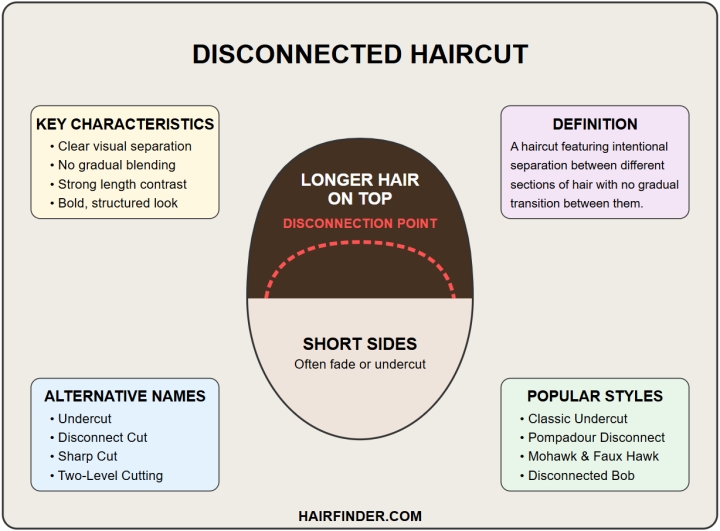Disconnected Haircut

A: A disconnected haircut is a style that features a clear, intentional separation between different sections of hair rather than a gradual blend. This creates a striking contrast in length, forming distinct zones with visible boundaries. Used in both men’s and women’s hairstyles, disconnection is a key element in many modern and vintage-inspired cuts.
The most common variation features very short sides (often achieved with an undercut or fade) contrasted with significantly longer hair on top, with no gradual transition between the two. Disconnected haircuts rose in popularity with the resurgence of traditional barbering techniques, blending classic styling with contemporary trends.
To determine whether a haircut can be called disconnected or not, you need to look at certain characteristics. Disconnected haircuts typically feature:
• A clear visual separation between hair sections.
• No gradual blending between different lengths.
• Short or shaved sides with a longer top section.
• Strong contrast in hair lengths.
• A bold, structured, and modern aesthetic.
Alternative Names for Disconnected Cutting
Depending on regional terminology and specific variations, disconnected cutting is known by different names. Some of the most common are:
• Undercut: The most widely recognized term, referring to short or shaved sides with longer hair on top.
• Disconnect Cut: A straightforward alternative name.
• Block Cut: Used in some regions to describe the sharp separation between sections.
• Contrast Cut: Highlights the strong difference in hair lengths.
• Sharp Cut: Emphasizes the clean, defined lines.
• Two-Level Cutting: Describes the distinct separation between shorter and longer sections.

The placement and degree of length contrast often determine the haircut’s name. While some styles feature more subtle disconnections, all have a distinct separation between short and long sections.
• Classic Undercut: Features very short sides and back with longer hair on top that may hang over the shorter sections.
• Disconnected Pompadour: A bold hairstyle with short sides and a dramatically longer top, styled upward and back.
• Disconnected Bob: A bob cut with a noticeable contrast in length between the perimeter and interior layers, without blending.
• Side-Swept Disconnect: A disconnected cut where the longer top section is styled to one side.
• Mohawk & Faux Hawk: Hairstyles with a longer strip of hair in the center and much shorter sides.
• Two-Level Hairstyle: A cut featuring a distinct "step" between the shorter and longer sections.
The popularity of disconnected haircuts continues to grow, thanks to their many advantages. The sharp contrast creates a bold, eye-catching look that stands out. Despite the dramatic contrast, the longer top section offers versatility, allowing for various styling approaches.
Maintenance is also easier, as the clear division reduces the need for frequent hair salon visits to maintain blended sections, which traditional cuts require. Also, disconnected styles offer a great opportunity for creative expression, both through the cut itself and the different ways it can be styled.
©Hairfinder.com
See also:
Can you explain "disconnected layers" and how they are achieved?
The mullet haircut